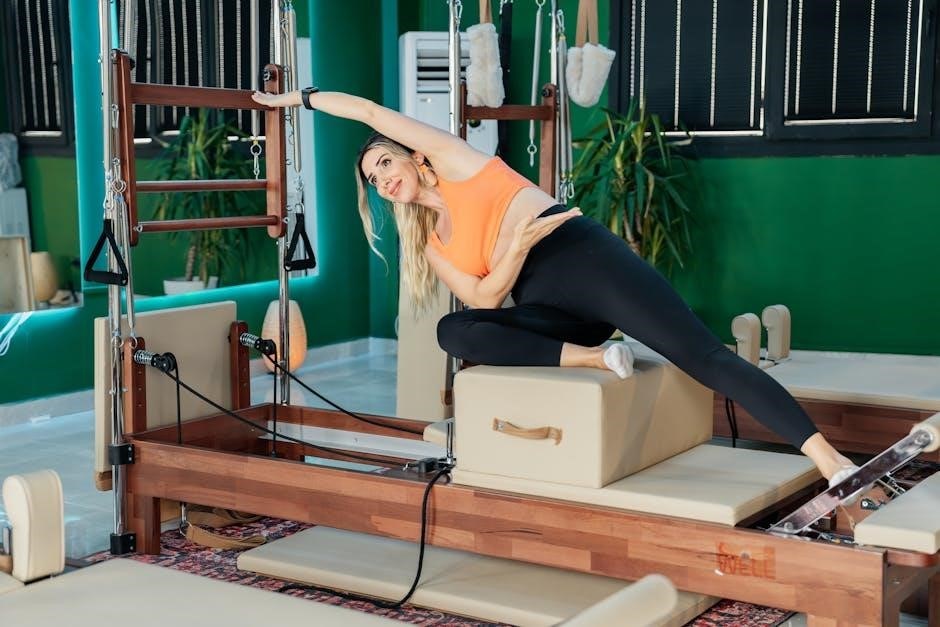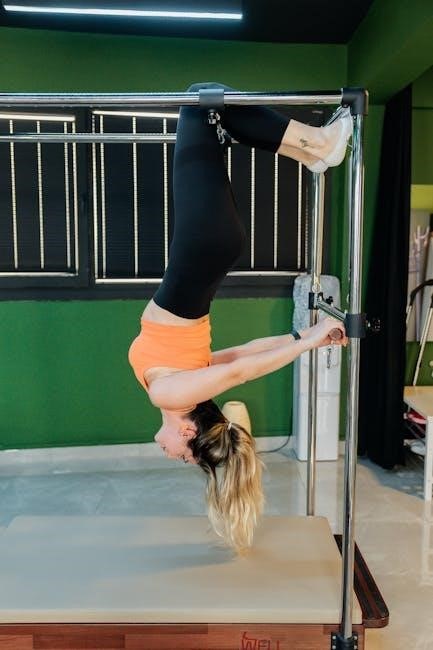stretches for piriformis pdf
Piriformis stretches are popular exercises to relieve sciatica and improve hip flexibility․ Available in downloadable PDF guides‚ these routines offer simple‚ effective stretches for home practice without equipment․ Ideal for tight muscles or piriformis syndrome‚ they promote comfort and mobility․ Download your guide now for a structured stretching routine․
Overview of the Piriformis Muscle
The piriformis muscle is a small‚ deep gluteal muscle located near the base of the spine․ It originates from the anterior surface of the sacrum and attaches to the greater trochanter of the femur․ This muscle plays a crucial role in hip rotation‚ stabilizing the pelvis‚ and aiding in balance during walking․ The piriformis muscle is closely associated with the sciatic nerve‚ which can sometimes become irritated due to muscle tightness or inflammation․ Understanding its anatomy and function is essential for effectively addressing piriformis-related discomfort and developing targeted stretching routines․
What is Piriformis Syndrome?
Piriformis syndrome is a condition characterized by pain in the buttocks and potentially radiating down the leg due to irritation of the sciatic nerve by the piriformis muscle․ It often results from muscle tightness‚ inflammation‚ or overuse‚ commonly affecting individuals who sit for extended periods or engage in repetitive hip movements․ Symptoms include tenderness in the buttock region‚ difficulty sitting comfortably‚ and pain during activities like walking or climbing stairs․ While it can mimic sciatica‚ piriformis syndrome is specifically related to muscle dysfunction rather than nerve root compression․ Stretching exercises‚ such as those detailed in downloadable PDF guides‚ are a key component of treatment to alleviate symptoms and restore normal muscle function․
Why Stretching is Important for Piriformis Health
Stretching the piriformis muscle is essential for maintaining flexibility‚ reducing muscle tightness‚ and preventing discomfort․ Tight piriformis muscles can compress the sciatic nerve‚ leading to pain and limited mobility․ Regular stretching helps alleviate symptoms of piriformis syndrome‚ improves hip joint mobility‚ and enhances overall lower body alignment․ By incorporating targeted stretches‚ individuals can reduce the risk of muscle imbalances and promote long-term muscle health․ Stretching also plays a key role in post-exercise recovery‚ preventing stiffness and ensuring optimal muscle function․ Downloadable PDF guides provide structured routines to make stretching convenient and effective for piriformis health․

Understanding Piriformis Syndrome
Piriformis syndrome occurs when the piriformis muscle irritates the sciatic nerve‚ causing pain in the buttocks and legs․ Tightness in the muscle is a common cause‚ and stretching exercises are often recommended to alleviate symptoms․ Downloadable PDF guides offer structured routines for effective management of piriformis syndrome through targeted stretches․
Causes and Symptoms of Piriformis Syndrome
Piriformis syndrome is often caused by tightness or inflammation of the piriformis muscle‚ which can compress the sciatic nerve․ Symptoms include pain in the buttocks and legs‚ worsening with sitting or activity․ Tenderness near the hip and limited mobility are common․ It can result from overuse‚ prolonged sitting‚ or repetitive movements․ Sciatica-like symptoms‚ such as numbness or tingling‚ may occur․ Downloadable PDF guides provide detailed exercises to address these symptoms and improve muscle flexibility․ Early intervention with stretching can prevent further discomfort and promote recovery․ Regular practice helps alleviate pain and restore normal movement patterns effectively․
How Tight Piriformis Muscles Affect the Body
Tight piriformis muscles can lead to discomfort and limited mobility․ They often cause lower back pain‚ stiffness‚ and difficulty sitting comfortably․ Sciatic nerve irritation may result‚ causing numbness or tingling in the legs․ Tightness can also alter gait and posture‚ straining nearby muscles․ Prolonged sitting or repetitive movements exacerbate the issue․ Downloadable PDF guides offer targeted stretches to alleviate these effects․ Regular stretching helps restore flexibility‚ reduce pain‚ and improve overall hip function‚ ensuring proper movement and comfort in daily activities; Addressing tightness early is key to preventing long-term discomfort and maintaining optimal muscle balance․
The Role of Stretching in Preventing Piriformis Syndrome
Stretching plays a crucial role in preventing piriformis syndrome by maintaining muscle flexibility and reducing tightness․ Regular stretching exercises can alleviate sciatic nerve irritation‚ a common symptom of the condition․ Strengthening nearby muscles through stretching helps improve posture and gait‚ reducing strain on the piriformis․ Consistent routines‚ as outlined in downloadable PDF guides‚ can prevent muscle imbalances and promote long-term relief․ By incorporating these stretches into daily practice‚ individuals can effectively manage symptoms and enhance overall hip mobility‚ ensuring a proactive approach to muscle health and discomfort prevention․

Seated Piriformis Stretches
Seated stretches target the piriformis muscle effectively‚ offering relief from sciatica and improving hip flexibility․ Cross-leg and side stretches are popular‚ easy to perform‚ and convenient for daily routines․
Cross-Leg Stretch for Piriformis
The Cross-Leg Stretch is a simple yet effective exercise to relieve piriformis tightness․ Sit on a chair with your right ankle resting above your left knee․ Gently pull your right knee toward your chest until you feel a stretch in your buttock․ Hold for 20-30 seconds and repeat on the other side․ This stretch targets the piriformis muscle‚ helping to alleviate sciatica symptoms and improve hip mobility․ Perform 2-3 times daily for optimal results․ Ensure proper posture and avoid forcing the stretch beyond a comfortable range to prevent discomfort․
Seated Side Stretch for Piriformis
The Seated Side Stretch targets the piriformis muscle and hip area․ Sit on a chair with feet flat on the floor․ Place your right hand on the seat beside your right thigh․ Gently slide your left hand down your left thigh toward your knee‚ stretching the right side of your hip and buttock․ Hold for 20-30 seconds and switch sides․ This stretch improves flexibility and reduces tension in the piriformis‚ aiding in sciatica relief․ Perform 2-3 times daily‚ ensuring smooth movements to avoid discomfort․ Consistency enhances overall hip mobility and muscle balance․

Standing Piriformis Stretches
Standing piriformis stretches improve balance and target the muscle effectively․ Techniques like Figure-4 and hip flexor stretches relieve sciatica․ Perform daily for optimal results and prevention․
Standing Figure-4 Stretch
The Standing Figure-4 Stretch targets the piriformis muscle to relieve tightness and sciatica․ Stand with feet hip-width apart‚ cross one ankle over the opposite knee‚ and bend at the hips to deepen the stretch․ Hold for 20-30 seconds on each side․ This stretch improves hip mobility and reduces discomfort․ Perform it daily for optimal results․ It’s convenient for any setting and requires no equipment․ Modify the stretch by adjusting the depth to suit your flexibility level․ Regular practice enhances flexibility and prevents piriformis-related pain․
Standing Hip Flexor Stretch
The Standing Hip Flexor Stretch targets the hip flexors and indirectly benefits the piriformis muscle․ Stand in a lunge position with your back knee nearly touching the ground and your front thigh parallel to the floor․ Slowly push your hips forward until a gentle stretch is felt in the front of your hip․ Hold for 20-30 seconds and switch sides․ This stretch helps relieve sciatica symptoms and improves hip mobility․ Perform it 2-3 times daily for optimal results․ Modify the depth based on comfort‚ and use a wall or chair for balance if needed․

Supine Piriformis Stretches
Supine piriformis stretches target the muscle while lying on your back‚ promoting relaxation and ease of movement․ They effectively relieve sciatica symptoms and improve hip flexibility․ Perform these stretches gently‚ holding each for 20-30 seconds․ Ideal for individuals with limited mobility‚ they can be done with or without equipment․ Download a free PDF guide for detailed instructions and visuals to enhance your routine and ensure proper form for maximum benefit․
Supine Piriformis Stretch with Foot on Ground
Lie on your back with knees bent and feet flat on the ground․ Cross one leg over the other‚ placing the foot on the opposite knee․ Gently press the knee toward your chest until a mild stretch is felt in the buttock․ Hold for 20-30 seconds‚ then switch sides․ This stretch targets the piriformis muscle effectively‚ providing relief from sciatica and piriformis syndrome․ Perform 3 sets of 10 repetitions daily for optimal results․ It’s a gentle yet effective exercise that enhances flexibility and reduces discomfort in the hip and lower back region․
90/90 Stretch for Piriformis
Sit on the floor with your legs bent at 90-degree angles‚ with one knee pointing upward and the other foot resting on the ground․ Place your hands behind you for support․ Gently press your hips downward‚ stretching the back leg’s piriformis muscle․ Hold for 20-30 seconds and repeat on the other side․ This stretch targets the piriformis and hip rotators‚ providing relief from tension and improving flexibility․ Perform 3 sets of 10 repetitions daily․ It’s a gentle and effective exercise for addressing piriformis tightness and sciatica symptoms‚ making it ideal for daily stretching routines․

Supine Hip Rotation Stretch
Lie on your back with knees bent‚ feet flat on the floor․ Cross one leg over the other‚ resting your foot on the knee of the opposite leg․ Gently press the crossed knee away from your chest until a stretch is felt in the outer hip․ Hold for 30 seconds and repeat on the other side․ This stretch targets the piriformis and hip rotators‚ helping to release tension and improve flexibility․ Perform 3 sets daily to alleviate sciatica symptoms and maintain hip mobility․ It’s a simple yet effective exercise for piriformis relief․

Additional Exercises for Piriformis Relief
Clamshell exercises and bridge poses strengthen glutes and improve hip stability․ Nerve flossing and prone hip extensions also relieve sciatica and piriformis tension effectively․ Try them daily for better mobility․
Nerve Flossing for Sciatica and Piriformis Syndrome
Nerve flossing targets sciatica and piriformis syndrome by relieving nerve irritation․ This technique involves gentle movements that reduce pressure on the sciatic nerve‚ improving mobility and discomfort․ Begin by sitting‚ then extend and flex the affected leg‚ keeping the knee straight․ Repeat this motion 10-15 times‚ breathing deeply to relax․ Regular practice can significantly alleviate symptoms and enhance overall lower body flexibility․ Incorporate nerve flossing into your routine for lasting sciatic relief and improved posture․
Clamshell Exercise for Glute and Piriformis Activation
The clamshell exercise strengthens the glutes and piriformis‚ improving hip stability․ Lie on your side with knees bent and feet touching․ Lift the top knee while keeping feet together‚ squeezing the glutes at the top․ Hold for 5 seconds‚ then lower slowly․ Perform 15-20 repetitions on each side․ This exercise enhances muscle activation‚ reducing piriformis tightness and promoting proper hip alignment․ Regular practice can prevent injuries and improve overall lower body strength and flexibility‚ making it an essential addition to any stretching or strengthening routine for piriformis health․
Bridge Exercise for Strengthening and Stretching
The bridge exercise is a versatile movement that strengthens the glutes and lower back while gently stretching the piriformis․ Lie on your back with knees bent and feet flat on the floor․ Slowly lift your hips toward the ceiling‚ squeezing your glutes at the top‚ then lower back down․ This exercise improves hip mobility and reduces muscle tension․ Perform 10-15 repetitions‚ resting between sets․ It’s an excellent addition to a piriformis care routine‚ promoting strength and flexibility while alleviating discomfort․ Regular practice enhances posture and reduces the risk of muscle imbalances in the lower body․

Maximizing the Effectiveness of Your Stretching Routine
Combine consistent stretching with strengthening exercises‚ use props for better alignment‚ and listen to your body to enhance results and prevent injury․ Regular practice is key․
How Often to Stretch the Piriformis Muscle
Stretching the piriformis muscle 2-3 times daily is recommended‚ with 10-15 repetitions per session․ Consistency is key to relieving tightness and preventing discomfort․ Adjust frequency based on muscle tightness and physical activity levels․ For sedentary individuals‚ daily stretching is beneficial‚ while active people may need more frequent sessions․ Overstretching should be avoided to prevent muscle strain․ Incorporate stretches into your routine‚ especially after exercise or prolonged sitting․ Use the downloadable PDF guide for structured routines tailored to your needs․
Combining Stretching with Strengthening Exercises
Combining stretching with strengthening exercises enhances piriformis health by improving flexibility and muscle stability․ Strengthening exercises like clamshells and bridges support the glutes‚ reducing strain on the piriformis․ Post-strengthening stretches help maintain muscle length and prevent soreness; This balanced approach addresses both muscle tightness and weakness‚ crucial for long-term relief from piriformis syndrome․ Use the downloadable PDF guide to integrate these exercises into your daily routine for optimal results and sustained mobility․ A comprehensive routine ensures overall hip and lower back well-being‚ promoting active lifestyles without discomfort․
Using Props for Enhanced Stretching
Using props like resistance bands‚ foam rollers‚ or chairs can enhance piriformis stretches‚ making them more effective and comfortable․ Resistance bands add gentle tension‚ deepening the stretch‚ while foam rollers help release muscle tension pre- or post-stretch․ Chairs or walls provide support for balance during standing stretches․ These tools are especially helpful for beginners or those with limited flexibility․ Incorporating props can improve alignment and reduce strain‚ allowing for a more controlled and beneficial stretch․ Explore the downloadable PDF guide for creative ways to use household items to enhance your piriformis stretching routine and maximize results․

Safety and Precautions
Always consult a healthcare professional before starting piriformis stretches‚ especially if experiencing severe pain or underlying conditions․ Begin with gentle stretches and avoid movements that worsen symptoms․
When to Avoid Certain Stretches
Certain stretches should be avoided if they exacerbate pain or discomfort․ Individuals with acute injuries‚ severe inflammation‚ or recent trauma should refrain from stretching until healed․ If you experience sharp pain‚ numbness‚ or tingling during a stretch‚ stop immediately․ Always consult a healthcare professional before starting a stretching routine‚ especially if you have underlying medical conditions like fractures‚ osteoporosis‚ or spinal issues․ Modify stretches to suit your fitness level and avoid movements that worsen symptoms․ Prioritize gentle techniques and seek professional guidance to ensure safe and effective stretching practices․
Modifying Stretches for Different Fitness Levels
Stretching exercises for the piriformis muscle can be adapted to suit various fitness levels․ Beginners can start with gentle seated or supine stretches‚ while more advanced individuals may incorporate deeper stretches or resistance bands․ For those with limited mobility‚ using props like pillows or straps can enhance comfort and accessibility․ Intermediate levels can gradually increase stretch intensity or duration․ Advanced practitioners might explore dynamic stretches or combine piriformis stretches with core-strengthening exercises․ Always prioritize proper form and listen to your body to avoid overextension․ Modifications ensure safe and effective stretching for all fitness levels‚ promoting progress without discomfort․
Listening to Your Body During Stretching
Listening to your body during stretching is crucial to avoid injury and maximize benefits․ Pay attention to sensations—stretching should feel gentle and relieving‚ not painful․ If sharp pain occurs‚ stop the exercise immediately․ Mild discomfort indicates a productive stretch‚ but severe pain signals overextension․ Adjust your position orIntensity as needed․ Breathe deeply and naturally; holding breath can increase tension․ Honor your body’s limits‚ especially if recovering from injury․ Rest when needed and gradually increase flexibility over time․ Attuning to your body ensures a safe and effective stretching practice tailored to your needs and progress․ This mindful approach enhances overall well-being and muscle health․ Consistency and patience are key․

Downloadable Piriformis Stretch Guide
Access a FREE downloadable PDF guide featuring detailed piriformis stretches․ This printable resource includes easy-to-follow instructions‚ visuals‚ and routines to relieve tension and improve mobility at home․ Download now for instant access to effective exercises and start your journey to comfort and flexibility today․
How to Access the Free Piriformis Stretch PDF
Accessing the free piriformis stretch PDF is straightforward․ Visit websites like OrthoIndy․com/PTVideos or search for “piriformis stretches PDF” online․ Click the download link‚ save the guide‚ and print it for convenience․ Many resources offer instant access without registration․ Ensure the guide includes detailed instructions‚ visuals‚ and routines for effective practice․ This PDF is ideal for home use‚ providing structured exercises to relieve tension and improve mobility․ Download your copy today and start your journey to comfort and flexibility with easy-to-follow stretches․
Benefits of Using a Printable Stretching Guide
A printable stretching guide offers convenience and structure for your routine․ It provides clear instructions‚ visuals‚ and step-by-step exercises‚ ensuring proper form and effectiveness․ Portable and easy to use‚ it allows you to practice anywhere‚ whether at home‚ in the gym‚ or while traveling․ The guide helps maintain consistency‚ track progress‚ and stay motivated․ By following the outlined stretches‚ you can alleviate piriformis tension‚ improve flexibility‚ and enhance overall well-being․ Download your guide today and enjoy the simplicity of a well-organized stretching plan tailored to your needs․
Start your journey to piriformis health by downloading a printable guide․ Follow the structured stretches to alleviate discomfort and enhance mobility․ Consistency is key to lasting relief․
Final Tips for Maintaining Piriformis Health
Consistency is key to maintaining piriformis health․ Incorporate stretches like the supine piriformis stretch and 90/90 stretch into your daily routine․ Combine stretching with strengthening exercises‚ such as clamshells or bridges‚ to improve muscle balance․ Use props like yoga mats or straps for enhanced comfort․ For optimal results‚ consider downloading a Piriformis Stretch PDF guide for structured routines․ Additionally‚ practices like nerve flossing can complement your stretching regimen․ Always listen to your body and adjust exercises based on comfort․ Regular practice will help prevent tightness and improve mobility․ Prioritize these habits to maintain long-term piriformis health and reduce discomfort․
Encouraging Consistency in Your Stretching Routine
Consistency is crucial for effective piriformis stretching․ Aim to perform stretches like the seated cross-leg or standing figure-4 stretch 2-3 times daily․ Start with shorter sessions and gradually increase duration as comfort improves․ Incorporate a variety of exercises‚ including supine hip rotations and clamshell exercises‚ to keep routines engaging․ Use a printable Piriformis Stretch PDF guide to track progress and stay motivated․ Schedule stretching sessions at the same time each day to build a habit․ Over time‚ consistency will lead to improved flexibility‚ reduced tightness‚ and enhanced overall well-being․ Regular practice ensures sustained benefits for piriformis health․








Leave a Comment